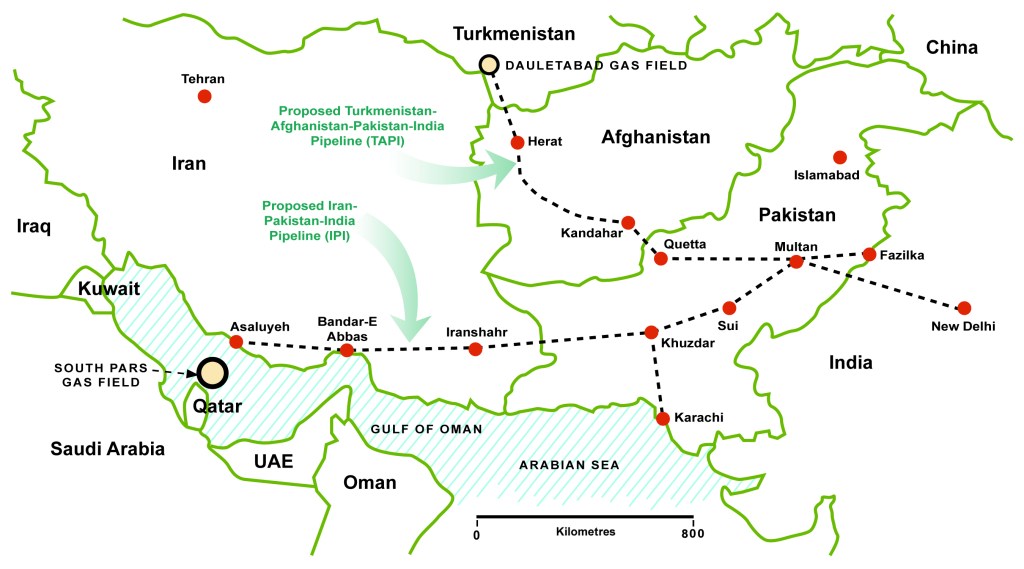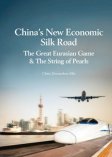China to Join Turkmenistan-Afghanistan-Pakistan-India Pipeline?

China has expressed interest in joining the Turkmenistan-Afghanistan-Pakistan-India (TAPI) gas pipeline project, by building a link from Pakistan to China. This could act as alternative to Chinese plans to build a fourth China-to-Turkmenistan pipeline. The China-to-Turkmenistan line has to cross several mountain ranges, and it would be cheaper and easier for China to build a line from Pakistan across the Karakoram Range to its Western border.
The Turkmenistan-Afghanistan-Pakistan-India (TAPI) pipeline is a 1,814 km trans-country natural gas pipeline running between the four countries. Also known as the Peace Pipeline, the TAPI pipeline will begin in Turkmenistan and traverse Afghanistan to reach Pakistan and India. A stone-laying ceremony was held to commemorate the start of construction of the Turkmenistan-Afghanistan section of the pipeline in December 2015 in Mary, Turkmenistan, near the Galkynysh gas field. The ceremony marking the beginning of construction of the Afghanistan-Pakistan section of the pipeline was later held in February 2018.
A special-purpose consortium company known as the TAPI Pipeline Company Limited (TPCL) was incorporated in November 2014 by Turkmengaz (Turkmenistan), Afghan Gas Enterprise (Afghanistan), Interstate Gas Service (Pakistan), and GAIL (India) to execute the US$7.5 billion project. Turkmengaz is the majority shareholder in TPCL.
The pipeline has been designed to serve for a 30-year period and is expected to commence operations in 2020. It is expected to transport 33 billion cubic meters (bcm) of natural gas a year. Work on the TAPI gas pipeline in Pakistan was scheduled to commence in May, 2018, but could not start due to change in government. The newly elected administration of Imran Khan is expected to start doing it soon. The targeted timeline for project completion was 2021, but under an alternate plan, the project would be finished by 2020.
The state-owned companies of Pakistan and India are each expected to purchase 42 percent of the total volume of produced gas, equating to approximately 14 bcm. Afghanistan is expected to purchase 16 percent of the gas, which approximates to 5.11 bcm, and will also receive US$400 million a year in transit fees for the pipeline. The project is being funded by the Asian Development Bank, which is also acting as transaction adviser for the development.
TAPI may also be linked to the proposed Iran-Pakistan-India Pipeline. While the Iran-Pakistan portion is currently being constructed, India has yet to agree to continue it from Pakistan into India, citing security concerns. That may change given that China is prepared to use the TAPI route to divert gas from the Pakistan spur, and run that north-east into Xinjiang Province.
China already has gas distribution and processing facilities running into Xinjiang from Kazakhstan; however these are a lot further north. The implications here are that China could then develop an internal secondary, southern-based pipeline either skirting or passing through the Taklimakan and Gobi deserts to a more central based facility closer to Gansu Province.
About Us
Silk Road Briefing is produced by Dezan Shira & Associates. The firm provides professional services to foreign investors and Governments on matters of Eurasian and Asian trade and investment, maintaining 28 offices throughout the region, including Beijing and Moscow. The practice maintains a China Belt & Road Advisory Desk. Please email silkroad@dezshira.com or visit us at www.dezshira.com
 Related Reading:
Related Reading:
![]() Turkmenbashi’s Caspian Window and the Turkmenistan Belt and Road
Turkmenbashi’s Caspian Window and the Turkmenistan Belt and Road
![]() Iran Completes First Phase of Chabahar Port and International North-South Transport Corridor
Iran Completes First Phase of Chabahar Port and International North-South Transport Corridor
China’s New Economic Silk Road
This unique and currently only available study into the proposed Silk Road Economic Belt examines the institutional, financial and infrastructure projects that are currently underway and in the planning stage across the entire region. Covering over 60 countries, this book explores the regional reforms, potential problems, opportunities and longer term impact that the Silk Road will have upon Asia, Africa, the Middle East, Europe and the United States.






